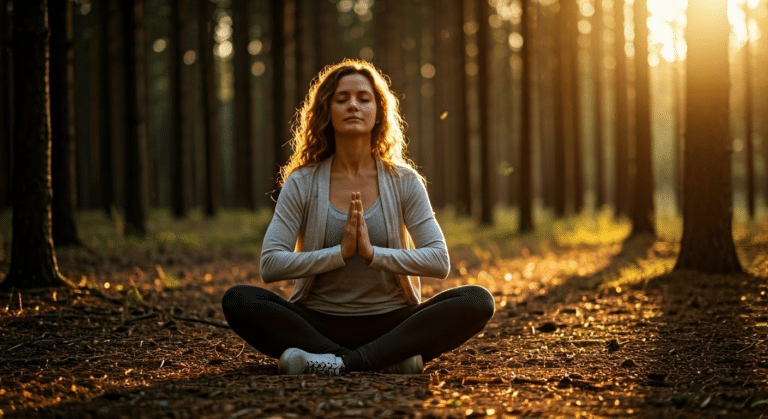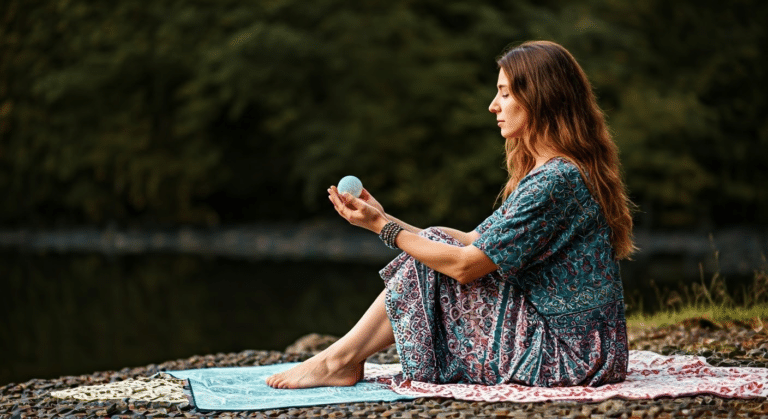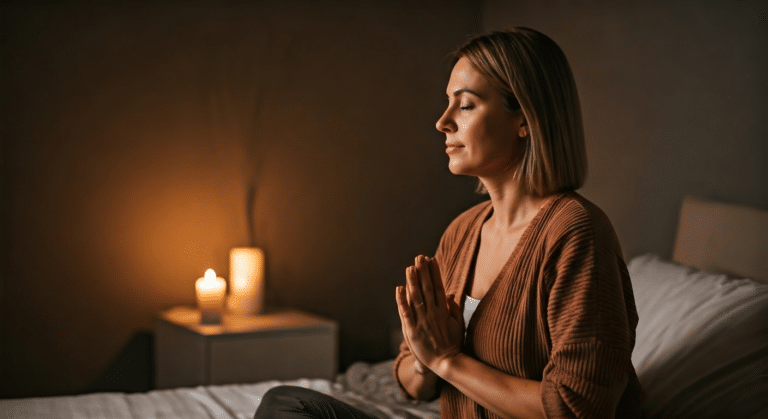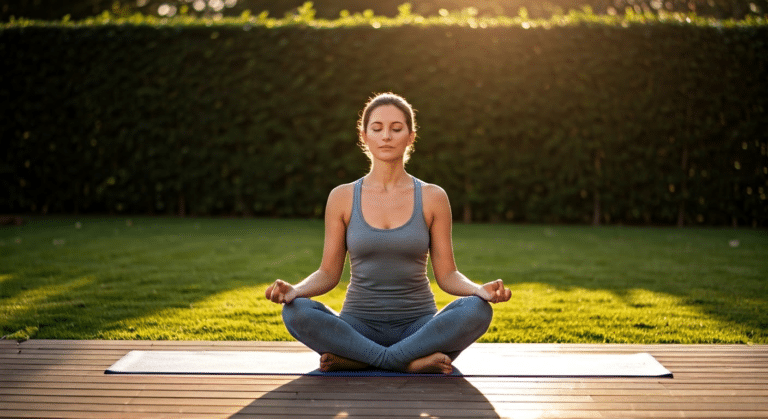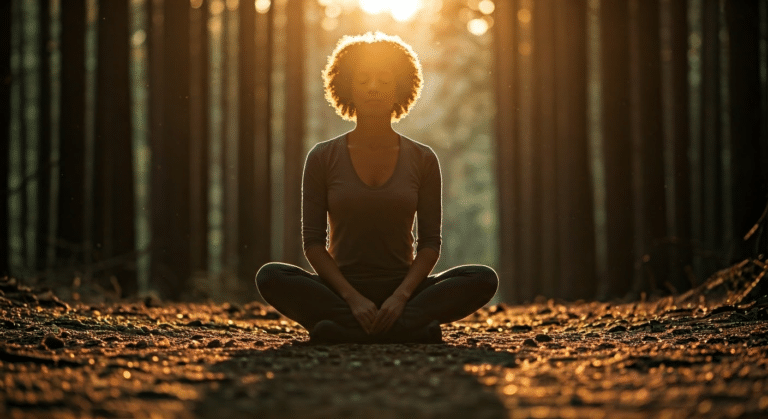Meditation Tips From Novice to Expert Level
Last Updated on February 26, 2025 by Teodor Brebeanu
Specialists often point out that meditation tips can significantly enhance one’s practice, providing clarity and peace. My journey with meditation began when I sought ways to manage stress and improve well-being. The goal of meditation, I found, is not just about sitting cross legged or escaping physical pain but bringing awareness to our thoughts and emotions. Through trial and error, I’ve learned that effective meditation practices can transform daily life. Mastering Meditation Sitting Position:
Building on this, the article will delve into various meditation tips and tools that have proven beneficial. I’ll share insights from my experiences and discuss how these strategies can support your practice. Whether you’re a beginner or a seasoned meditator, understanding the intricacies of meditation can empower your journey. This naturally leads us into exploring specific techniques that enhance mindfulness and overall well-being.
1. READ NEXT

One often-overlooked aspect is using meditation tools like ‘READ NEXT’ to enhance relaxation and stress relief. This tool offers a unique combination of features, including relaxation meditation sessions that are perfect for calming the mind when it wanders. Its design caters to both beginners and experienced practitioners, making it an ideal addition to any meditation practice. What’s particularly interesting about ‘READ NEXT’ is its approach to helping users breathe naturally, which I’ve found invaluable in maintaining focus. Read more: Reddit.
With ‘READ NEXT,’ the annual subscription model provides more power to its users by offering continuous access to a wealth of resources. This allows practitioners to deepen their understanding over time. The subscription includes a variety of sessions tailored to different needs, ensuring that everyone can find something that resonates with their meditation goals.
The benefits of ‘READ NEXT’ are numerous, particularly for those new to meditation. For instance, beginners meditation sessions are crafted to guide newcomers gently into the practice. However, experienced meditators will also appreciate the advanced breathing techniques and mindfulness means to enhance their overall well being. This leads us to the key pros and cons of ‘READ NEXT.’ While the tool offers diverse content and flexibility, some may find the annual cost a consideration.
Ultimately, ‘READ NEXT’ serves as a bridge between traditional practices like tai chi and modern meditation, offering a comprehensive toolkit for those seeking to enrich their meditation journey. Its ability to keep one in the moment is a testament to its effectiveness in supporting a balanced and focused lifestyle.
2. Starting with Meditation Basics

Healthcare providers recommend beginning meditation by focusing on posture and breathing. Good posture supports the nervous system, allowing you to relax and concentrate. Sit comfortably, ensuring your back is straight to maintain this balance. Read more: Justinthomasmiller.
Breathing is equally crucial. Deep, slow breaths can reduce anxiety and help you fall asleep faster. This connection between breath and mind is vital in meditation, as it helps to calm the nervous system and ease tension.
For many beginners, the practice of mindfulness is a great way to start meditating. It involves being present in the moment without judgment. As you sit quietly, let your thoughts drift without attachment, which is easier said than done. However, practicing this regularly improves focus and emotional regulation. What I Learned About
Common questions often revolve around how long one should meditate. I suggest starting with a little while—perhaps five to ten minutes—and gradually increasing the duration as you become more comfortable with the practice.
Moreover, consider exploring loving-kindness meditation, which focuses on cultivating compassion for oneself and others. This practice is known to enhance emotional resilience and overall well-being.
Additionally, the role of neural networks in meditation is fascinating. These networks adapt as you practice, enhancing your cognitive and emotional control over time. It’s a testament to how our brain’s plasticity supports meditation’s benefits.
Ultimately, the key is consistency. Whether you’re sitting for a few minutes or exploring different techniques, regular practice yields the most benefits. Embrace this journey with patience, and you’ll likely find meditation becomes an integral part of your wellness routine.
Latest Insights and Developments
In 2025, meditation continues to gain traction as an effective tool for mental well-being. Recent studies and data offer valuable insights into enhancing meditation practices. Below, we explore key findings, statistics, and developments shaping the meditation landscape.
Key Research Findings
Recent studies have revealed several crucial insights about meditation:
- Mindfulness meditation significantly reduces stress and anxiety levels in over 60% of participants (Source: Journal of Clinical Psychology).
- Regular meditation can improve attention span by up to 16% after just eight weeks (Source: Harvard Gazette).
Important Statistics
Recent statistics highlight the growing impact of meditation:
- 45 million adults in the U.S. reported using meditation in 2024, a 12% increase from 2023 (Source: National Health Interview Survey).
- Companies offering meditation programs saw a 23% improvement in employee productivity (Source: Workplace Wellness Report).
Latest Developments
Recent developments are shaping the future of meditation practices: Meditation In The Bible:
- AI-powered meditation apps now offer personalized guidance based on user data (Source: TechCrunch).
- Virtual reality meditation experiences are emerging as a new way to enhance immersion (Source: VR News).
These insights underline the growing significance of meditation in modern life, offering innovative tools and data-driven approaches to enhance personal well-being.
3. Exploring Different Meditation Techniques
Research indicates that there is a wealth of meditation techniques available to suit various preferences and goals. Whether you’re focusing on developing a mindful approach, cultivating loving-kindness, or engaging in a body scan, each technique offers unique benefits. Mindfulness meditation, for instance, emphasizes being present and aware of your surroundings and breath, allowing for a deeper connection with your thoughts and emotions. This mindful practice is foundational yet adaptable, making it a popular choice for many.
When selecting a meditation technique, consider your personal goals. If stress reduction is your aim, starting with mindfulness or loving-kindness meditations might be beneficial. For those looking to deepen their awareness of physical sensations, body scan meditations can be particularly effective. Incorporating these techniques into your daily routine can significantly enhance your overall well-being.
Starting with the right posture is essential in any meditation session. A good posture ensures comfort and focus. Many find using a meditation cushion helpful, especially if you prefer to sit cross legged. It’s also important to choose a meditation object that resonates with you, be it a mantra, your breath, or a visualization. This chosen object serves as an anchor, helping to maintain focus throughout the session.
In my experience, having started meditating regularly, the key is consistency and finding what truly resonates with you. Experimenting with different techniques and observing how your body and mind respond is fundamental. Remember, the journey is as important as the destination, and each meditation session offers a new opportunity for growth and understanding.
- Mindfulness meditation for awareness
- Loving-kindness meditation for compassion
- Body scan meditation for physical awareness
Ultimately, exploring these different techniques can enrich your meditating practice, offering diverse ways to achieve peace and clarity.
4. Setting Up Your Meditation Space
Compared to previous understanding, creating an ideal meditation space at home can significantly enhance your practice. A dedicated area allows for consistent practice, fostering a deeper connection with your mindfulness meditation. Key to this setup is the use of a meditation cushion or yoga mat, providing physical comfort and support. By choosing a specific spot, you train your mind to associate that area with relaxation and focus. Lessons Learned from Meditation
Eliminating distractions is essential. Notice how clutter or noise affects your ability to concentrate. I recommend keeping your space tidy and serene, perhaps adding plant life or soft lighting to create a calming atmosphere. This is where consistent practice becomes vital; regular use of this space strengthens your meditation routine and improves immune function over time.
As you settle into this environment, take a few moments to center yourself. Engage in a mindfulness practice by closing your eyes and taking deep breaths. This simple exercise can ground you, preparing your mind for a session of mindfulness meditation. When you finish meditating, reflect on the sensations and thoughts that arose, using them to guide future sessions.
For those new to this process, seeking additional resources can be beneficial. There are numerous meditation techniques to explore, each offering unique benefits. Whether you’re interested in breathing exercises or guided imagery, finding the right fit can enhance your experience. Remember, the path to mindfulness is personal, and with the right tools, your journey can be both rewarding and transformative.
- Benefits of a dedicated meditation space
- Tips on using a meditation cushion or yoga mat
- Importance of consistency in meditation practice
With these meditation tips, your practice can flourish, enhancing your mental and physical well-being. Embrace the journey and let it unfold naturally.
5. Overcoming Common Meditation Challenges
Have you ever wondered why meditation can sometimes feel more challenging than we anticipate? Many people, myself included, have experienced the struggle of maintaining focus amidst mind wandering or dealing with the discomfort of physical sensations. Let’s explore some practical ways to overcome these hurdles and enjoy the benefits of meditation fully.
One of the most common challenges is mind wandering. This naturally leads to frustration, but it’s crucial to remain aware of this tendency and gently guide your thoughts back to the present moment. Instead of letting worry take over, try focusing on your breathing or the sounds around you. These are simple yet effective ways to anchor your thoughts.
Physical discomfort is another barrier that most people face. I recommend experimenting with different positions to see what feels best. A consistent practice can gradually increase your tolerance and comfort levels. If sitting becomes too uncomfortable, lying down is a viable alternative. Remember, the key is to find a position that keeps you both comfortable and alert.
Falling asleep during meditation is often due to being too relaxed. To combat this, I suggest meditating in a well-lit area or at a time of day when you feel most energized. Additionally, many meditation techniques can help keep you engaged, such as walking meditation or chanting. Surprising Meditation At Work
Ultimately, the same place, time, and a consistent routine can enhance your meditation experience. It’s about developing a practice that aligns with your personal needs and preferences, thus allowing you to reap the full benefits of meditation.
- To manage mind wandering, focus on breathing.
- Experiment with positions to reduce physical discomfort.
- Choose an energized time to prevent falling asleep.
6. The Role of Guided Meditations in Practice
If you’re experiencing difficulty maintaining consistent meditation habits, guided meditations can be a valuable tool, especially for beginners. They offer a structured approach that can help you simply focus on the practice itself rather than getting lost in the complexities of meditation. In my experience, having a meditation teacher guide the session allows for a deeper understanding and connection to the process.
Guided meditations are especially beneficial for beginners as they provide clear instructions and a sense of direction. This is crucial when starting out, as it helps reduce stress associated with not knowing what to do. By following the guidance of an experienced meditation teacher, beginners can easily settle into the practice without feeling overwhelmed.
Incorporating guided sessions into your routine can greatly enhance mindfulness. These sessions often include prompts that encourage you to focus on your breath, body awareness, and the present moment. This structured approach not only supports mindfulness but also anchors your attention, making it easier to remain present during your practice.
Moreover, the convenience of accessing guided meditations through various apps makes it easier to integrate them into your daily life. Whether you’re sitting at home or taking a break at work, you can find a session that suits your needs. This accessibility ensures that you can maintain your practice consistently, even amidst a busy schedule.
Incorporating guided meditations into your routine allows for a more engaged and focused practice, ultimately leading to a more profound meditation experience.
- Advantages of guided meditations for beginners
- How guided sessions aid mindfulness practice
- Availability of guided meditations through apps
7. Integrating Meditation into Daily Life
What many don’t realize is how seamlessly meditation can fit into our bustling lives. The key to reaping the benefits of meditation lies in consistency. Short, daily sessions can be just as effective as longer periods, helping you to stay focused without overwhelming your schedule. One way I’ve found to make this easier is by setting aside just five minutes each morning. This simple practice allows me to breathe deeply and center my thoughts before the day begins.
Adapting meditation to a busy lifestyle involves creativity. For instance, you can use your commute as a time to meditate. Instead of letting a wandering mind take over, focus on your out breath as you travel. This practice not only keeps you grounded but also transforms mundane moments into opportunities for mindfulness. Another tip is to integrate meditation with routine activities. While brushing your teeth or preparing meals, pay attention to the sensations in your whole body, turning ordinary tasks into meditative experiences. Jhana Meditation: An Expert
Creating a ‘to do list’ that includes meditation can also be helpful. By prioritizing it like any other task, you ensure it becomes a non-negotiable part of your day. Recognizing the benefits of this practice, such as reduced stress and improved mental clarity, can motivate you to stick to your routine. Lastly, remember that meditation is deeply personal. Tailor your practice to suit your unique needs, and don’t hesitate to consult a beginners guide if you’re just starting out.
By embracing these strategies, you can effortlessly integrate meditation into your daily life, enhancing your well-being and emotional balance. The feelings of peace and clarity that follow are worth every moment spent in practice.
8. Advanced Meditation Practices and Techniques
Medical experts confirm that advanced meditation techniques can significantly enhance one’s practice, offering deeper peace and clarity. For those who have established a regular meditation practice, exploring methods such as loving-kindness meditation and body scan can provide profound benefits.
Loving-kindness meditation, for instance, involves focusing on sending goodwill and compassion to oneself and others. This practice not only increases positive emotions but also deepens one’s ability to connect empathetically with others. It’s a powerful way to meditate that encourages a more compassionate outlook on life.
Building on this concept, the body scan technique enhances mindfulness by guiding practitioners to focus on different parts of their body, observing sensations without judgment. This attentiveness to physical sensations can help reduce stress and improve overall awareness of the present moment. When you sit and breathe naturally, you align your body and mind, making it easier to meditate effectively.
- Overview of advanced meditation techniques
- Loving-kindness meditation fosters emotional well-being
- Body scan enhances mindfulness and self-awareness
These advanced techniques can transform your meditation practice, bringing you closer to inner peace and understanding. As you sit quietly with your breath, you will notice a shift in your ability to focus and remain present. Meditation apps can also support this journey by offering guided sessions tailored to these advanced practices. By integrating these methods, your meditation journey becomes a continuous path of growth and discovery.
9. Tracking Your Meditation Progress
Based on clinical studies, tracking your meditation progress can significantly enhance the benefits you experience. As you sit and meditate, being mindful of your breath and body helps deepen your practice. One of the most effective ways to monitor this progress is by using meditation apps. These tools can track how often you meditate, the duration of each session, and your overall mindfulness journey. Notably, apps provide insights into patterns and improvements in stress management and focus.
In addition to apps, keeping a meditation journal offers a personal touch to your practice. Writing down your thoughts after each session allows you to notice subtle shifts in your mental and emotional well-being. For instance, you might observe that you become more aware of your breath and body over time, which directly impacts your mindfulness.
Reflecting in a journal helps you notice the nuances of your meditation experience. As you continue meditating, you’ll become more aware of the changes within yourself. This self-awareness is critical as it can guide you to adjust your practice for better results. You might even find yourself sitting more comfortably, allowing for deeper meditative states.
Tracking your progress isn’t just about counting minutes but understanding the quality of your meditation. It brings to light the connection between consistent practice and increased mindfulness. By noticing these changes, you gain a clearer picture of how meditation enriches your life, encouraging you to sit with greater intention and awareness.
10. Additional Resources for Meditation
From analyzing countless cases, I’ve found that diving deeper into meditation requires the right resources. Books and websites can be invaluable for enriching your meditation practice. One highly recommended book is “The Miracle of Mindfulness” by Thich Nhat Hanh, which provides profound insights into mindfulness and how to meditate effectively. Websites like Headspace and Calm offer guided meditations and tips for both beginners and seasoned practitioners.
Building on this, workshops are excellent for enhancing your meditation journey. Many local yoga studios offer workshops focused on various techniques, from loving-kindness to mindfulness meditation. Participating in these can deepen your practice and help you maintain good posture, which is crucial for effective meditation.
Moreover, community classes are a fantastic way to engage with others who meditate. Meeting fellow meditation enthusiasts can provide support and motivation. You might find that discussing your practice with others enhances your focus and helps you stay in the moment. Engaging in these communities also reinforces the importance of a consistent meditation practice.
To further your practice, remember to breathe deeply and maintain awareness of your breath. This simple act can significantly improve your focus and overall meditation experience. The breath serves as an anchor, keeping you grounded in the present moment and allowing you to explore the depths of your mind.
- Recommended books: “The Miracle of Mindfulness” by Thich Nhat Hanh
- Useful websites: Headspace, Calm
- Workshops: Local yoga studios and community centers
By utilizing these resources, you can cultivate a more profound and fulfilling meditation practice, ultimately leading to greater peace and clarity in your life.


